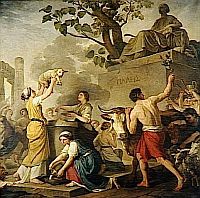
|
|
Ancient Roman |
|


| Much of Roman mythology and the associated star lore has been an adaptation of Greek mythology. But in a number of cases, Roman star lore took on a life of its own. |



|
Aquarius
According to R.H. Allen, in the Roman
Zodiac, the constellation was shown as a peacock and sometimes as a Goose.
|
 Juno and Peacock
Juno and Peacock© Walter Crane
|



|
|
Aquila
The Roman Republic adopted the Greek concept of the eagle holding
Jupiter's thunderbolts and made the image its coat of arms.
|

|



|
|
Boötes
Segnius, the official name of γ Boötis is the result of a Latin
mistranscriptions of an Arabic rendering of Boötes.
θ, ι and κ Boötis are commonly known as the Herdsman's upraised fingers. However, they were given the Latin name Asellus, meaning donkeys.
The names
Asellus Primus,
Asellus Secondus and
Asellus Tertius, the first, second and third donkey are not officially approved by the
IAU.
|



|
|
Canis Major
Roman mythology refers to Canis Major as Custos Europae, the dog guarding Europa but failing to prevent her abduction by Jupiter in the form of
a bull, and as Janitor Lethaeus, "the watchdog".
|
 Cerebus, the watch dog
Cerebus, the watch dogCaeretan hydria, ca 530 BC Source: Wikipedia, |



|
|
Leo
The Roman poet Ovid called the constellation Herculeus Leo and Violentus Leo.
|
 Heracles fighting the Nemean lion
Heracles fighting the Nemean lionRoman era relief, 2nd century AD Souce: Wikipedia |



|
|
Libra
Libra is perhaps Rome's biggest contribution to the otherwise Mesopotamian and Greek Zodiac constellations. In ancient Greece, the stars of Libra were
seen as the claws of Scorpius. In the Almagest, written about 150 AD,
Ptolemy still referred to this constellation as "The Claws".
|

|
When the perception of the constellation switches from "Claws" to "Scales", it was no longer associated with
Scorpius, but rather with
Virgo, which in Greek mythology was depicted as
Astraea, the goddess of justice. Astrea was an epitaph of the actual Greek goddess of justice,
Dike.
 In Roman mythology, Dike became Justitia, an allegorical personification of the moral force in judicial systems, which was always depicted with a blindfold and sword and a beam balance (the Scales).  Source: Wikipedia |
 Justitia holding the scales
Justitia holding the scalesCourt of Final Appeal, Hong Kong Source: Wikipedia |



|
|
Lyra
To the Romans, Lyra was knows as Vultur Cadens (Falling Vulture) or Aquila Cadens (Falling Eagle).
|



|
|
Milky Way
The Romans adopted the concept of spilled milk forming the Milky Way from
Greek Mythology. However,
Roman author Gaius Julius Hyginus puts a different spin on the idea.
|

|



|
|
Pleiades
In Roman mythology, Maia, the oldest of the
seven sisters, was celebrated as the
Goddess of Spring, representing growth, renewal and fertility. The month of May (Maius in Latin) is believed to have been named after her.
The star cluster of the Pleiades is part of the constellation Taurus, but given the amount of Star Lore related to them, they deserve a separate entry. |
 Mercury and Maia inside a silver cup
Mercury and Maia inside a silver cuplate 2nd century AD Souce: Wikipedia |



|
Taurus
In ancient Greece, the Hyades, a star cluster within Taurus were called
Ὑάδες the "rain-makers." A similar sounding Greek
word, ὗς (hys), which means "swine" let to the Romans calling the Hyades "piglets."
|
 Festival of Pales
Festival of PalesJoseph-Benoît Suvée, 1783 Sourcce: Wikipedia |



|
|
Ursa Major
Ian Ridpath tells us that
Germanicus Caesar "... seems to have been the first to mention a third, now-common identity – he
said that the bears were also called ploughs because, as he wrote, ‘the shape of a plough is the closest to the real shape formed by their stars...
|



|
|
Virgo
Both Ptolemy, in the
Almagest, and
Hyginus in the
Poeticon Astronomicon called the constellation Παρθένος -
Parthenos, which is Greek for virgin.
|
 Parthenos in Poeticon Astronomicon
Parthenos in Poeticon AstronomiconSource: fineartamerica.com |


|
Back to Star Lore |
Back to Mythology |
Back to Space Page |
Back to English |
 Back to Start Page |